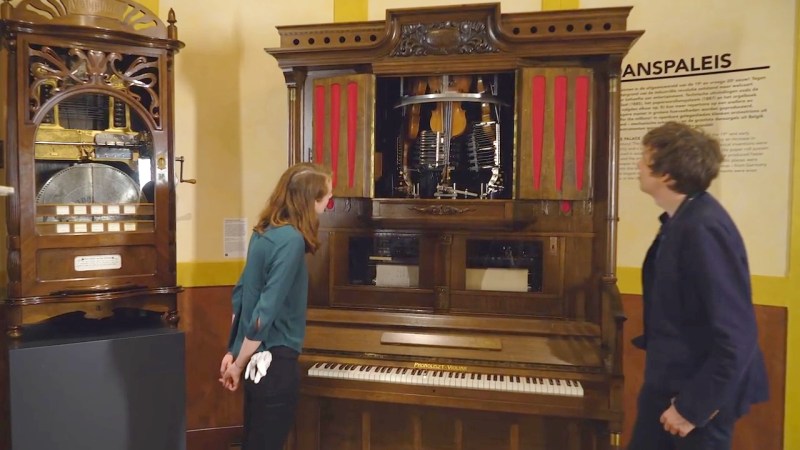[Martin], of the YouTube channel [WinterGatan], recently uploaded a video tour of the Phonoliszt Violina, an orchestrion, or a machine that plays music that sounds as though an orchestra is playing. The interesting thing about this one is that it plays the violin. At the time of its construction, people weren’t even certain such a thing would be possible and so when [Ludwig Hupfeld] first built one around 1910, it was considered the eighth wonder of the world.
The particular one shown in the video is at the Speelklok Museum in Utrecht, the Netherlands. The bow is a rotating cylinder with 1300 horsehairs. To get the sound of a single violin, it actually uses three of them. Rather than the bow being moved to press against the strings, the violins tilt forward to make their strings contact the rotating bow. Only one string is used per violin, hence the reason that three violins are needed. The volume is controlled by making the bow rotate faster for more volume, and slower for less. Mechanical fingers press against the strings with cork to more closely imitate the human fingertip.
The machine consists of both the mechanical violin and piano under the guidance of two paper rolls, with one roll playing at a time. See and hear it in action in the video below.
The name [WinterGatan] may sound familiar as they’re also the ones that created the incredible marble music machine that went viral last year. But if it’s more violin playing machines you’re after, you’ll like the Ro-Bow which uses modern technology to play all the strings on a single violin.

















By recently you mean 2 weeks ago? This is very cool, especially the first time I saw it…. 2 weeks ago.
oh fuck you, new for me, so shut up.
And it still would have been new to you, had it been reported in a timely fashion
Nobody cares, fuck off
I care. I remember when hackaday was a primary source for new and cool information.
So you missed it 100 years ago?
Why don’t folks try leaving comments that show a little class?
Bothers the hell out of me that he’s touching the piano with bare hands while she’s wearing gloves.
If the docent didn’t make him wear gloves, I don’t think she minded. It makes sense since she probably touches the machines all day and he is a sort of guest of honor (since they are exhibiting his creation).
How they manage to make the rotating bow turn slower or faster reading the punched paper back in the 1900?
Arduino or RPi i guess
No you have to remember… this was before the Arduino and RPi!!!
Obviously they used a 555!
My guess is there are a number of rows of holes that refer to the speed. As everything is pneumatic, the more holes the more air there is to spin the bow around. Whether this is 1 hole, 2 holes, 3 holes etc, or a binary count instead, who knows?
It could be electric. The problem is we don’t if there are only two or three speeds, or a gradient of some sort. For a series of set speeds, it would just be different holes, like for the notes. For a gradient… that would be something more impressive.
I feel like I’m missing something with the ‘3 violins’ thing.
Doesn’t a violin have 4 strings?
Yup, but one string is not being used.
Yeah, I had a look around other articles about this and can confirm as well. Everything I read said only one string was used per violin.
This is mentioned in the video.
That is NOT a “self playing violin”. It isn’t even holding its bow!
Those seem more the size of violas (Violum?) than violins
The musical instrument museum in London has a working double violin version. It is a great little museum as is the nearby water and steam museum. They also have an original RCA Theremin. It needs restoration as it currently doesn’t work. When I was there, they were looking for a volunteer to restore it. I would have volunteered but I was just visiting London. There actually is very good information available on how to restore one.
This wasn’t the only one. Here in the US, the Mills Co. made a single violin with 4 “Dremel disc” bows and a piano with balanced symmetric shape for tuning stability. Violino Virtuoso. It was electric digital with solenoids tripping the notes, in contrast to the pneumatic tech of all other automatics of that time. It still used holes in paper roll. The government gave it an award in ’09 one as one of the 8 greatest inventions of the oughts.